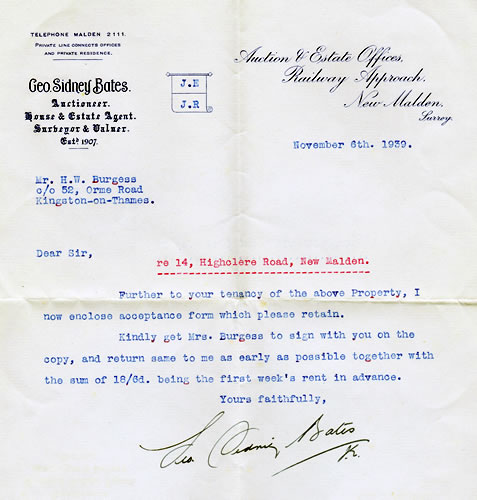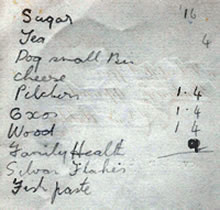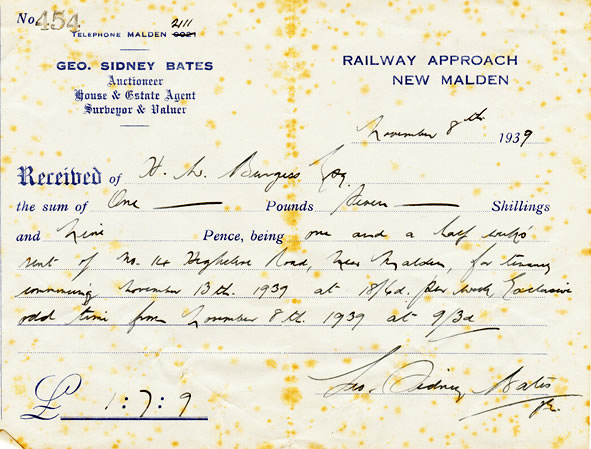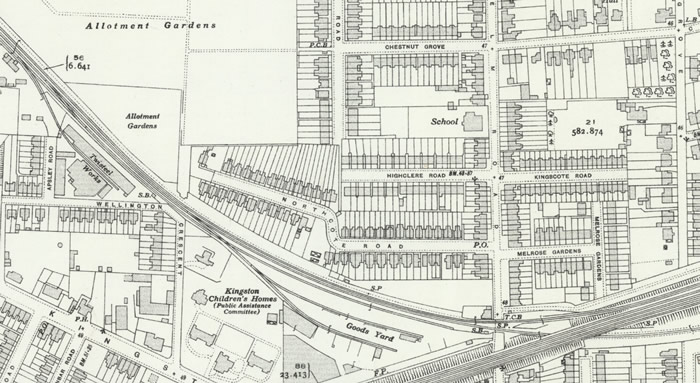| Highclere Road in WW2 | |
|
Memorabilia
|
When the 1939 Register was taken on Friday 29 September 1939 after war had been declared on 3 Sept, Harold and Rose Burgess were in the process of moving, so were staying with Harold’s brother Albert and his wife in Shortlands, Kent until they could take possession of their new home in Highclere Road, New Malden. However, Harold had already started work at Bentalls in Kingston so during the week he was living with another brother, Reg, in Hounslow. Bentalls was, and is, a large department store and Harold worked in the second hand furniture department which my brother thinks may have bought furniture from people who were giving up their homes to move out of London because of the war.
By 6 November it appears that the family were staying with the Bennett family at 52 Orme Road, New Malden, because the letter from George Sidney Bates, House and Estate Agent confirming their tenancy was sent to Harold care of that address. Nora Bennett née Doyle was a close friend of Rose from their school days in Harringay. She is pictured in a photograph with Rose's father, Mark Burgess, standing outside his piano manufacturing business. To see it use the following link to a page about Mark..
On the back of the letter from Bates is what looks like a faint shopping list written in pencil by my mother. The third item reads "Dog small Bis". Could this be dog biscuits? My brother knows why.
Yes we did have a dog called Bluff. I think he was so named because when he first arrived he would pretend he needed to go out into the garden, and when let out not need to relieve himself after all. He was a cross - my recollection is a Newfoundland/Red Setter cross. But since these words meant nothing to me that may be totally wrong. It was certainly early in the war that we acquired him. We moved to New Malden at the end of 1939 (my 5th birthday was there). Auntie Winnie and Uncle Harry and Nan moved to Wimbledon later - but I have little idea how much later. I remember us having Bluff there - he bit Nan's hand once when she tried to take his dish from him. I think it was from there Dad started taking him out for exercise while riding his bike. I believe on the first outing he tried to cross to the other side of the bike at some stage and overturned it. However he was quick to learn and never made that mistake again. I also remember him tied up in the Garden at 14 Highclere and his playfully trying to grab our feet as we played on our tricycles.
A receipt from Bates suggests that the rental agreement for No. 14 commenced 13 November at 18/6d per week. Although they may have moved in a few days earlier as the last line of the receipt reads “Exclusive odd time from November 8th 1939 at 9/3d”. Previously they had lived in a ground floor flat at Falkland Road, Harringay where they shared a bathroom. It must have been quite a change for the family to have a whole house and garden to themselves.
By 1939 Highclere Road was full of houses but it had been a gradual development. Before the Great War only the first eight even numbered houses were shown on maps and Mrs Swift who lived at No. 16 used to say that when she moved in, hers was the last house before Norbiton Station, about a mile away to the north west. This is borne out by the two map extracts below, showing Highclere Road (between the railway junction and the school) in 1913 and 1935. 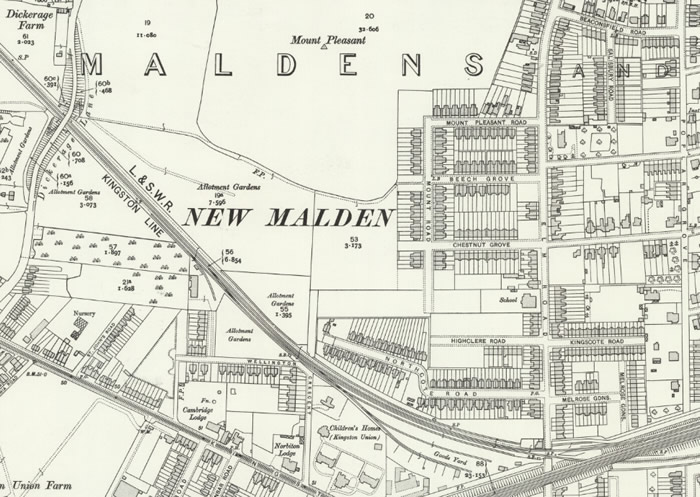
The area was well provided for, with enough local shops to do many a modern village proud. In Elm Road, within 100 yards of Highclere Road were: grocer/Post Office, greengrocer, butcher, baker, shoe repairer, newsagent/stationer, fishmonger, chemist, ladies hairdresser, electrical, haberdashery, hardware and baby clothes shops. Oh, and a sweet shop at the corner of Highclere Road which included in its stock sweets manufactured by Harold’s mother’s Hely family. Our family doctor had his surgery a block away at the corner of Chestnut Grove. My sister remembers my first shopping trip: You went to buy some caps for your gun, and we were all very amused because you took some of your pocket money and went shopping for the first time on your own and we all thought how grown-up you were getting. When you got back Dad asked you which shop you had been to. (Mrs. Reeves one way or Foremans the other) You replied it was the shop round the corner, so Dad asked who had served you and you replied the lady with black hair. Dad, still trying to find which shop you had been to asked where, and getting a bit fed-up with all the questions you said 'On her head'. Harold was not called up for military service. He was exempt for medical reasons. No doubt what was left of his lungs after TB in 1930 was a factor. Instead he was on fire watch duty in the road and the spare helmets were stored in the cupboard under the stairs at No. 14. It must have been a little crowded in there when the two children squeezed in after a daytime siren warning, but at least they were allowed chewing gum as a treat. Occasionally, the fire watchers would have practices and lay small bonfires, maybe about six, along the road and various strangers would walk up and back down the road. One of them would light the bonfires and the fire watchers would have to go and put them out. Sometimes the children were allowed to look out of the window to watch what was going on. As the bombing grew more intense the family began to use an Anderson shelter in the back garden of No. 12 where Mr and Mrs Hamlin lived. Harold took out bits of fencing between Nos. 12, 14 and 16 so that they and Mrs Swift at No. 16 could all hurry across when the siren sounded. Brick shelters were built in the playground of the boys’ junior school in Elm Road for those occasions when the siren sounded during the school day. Years after the war I remember them being used to store sports equipment. One of the nearest bombs landed at the end of Elm Road and demolished a large house on the corner with Kingston Road. It was a house that Rose’s sister Winnie had suggested the two families share, along with their parents Mark and Jane. A lucky escape for all eight of them. After Auntie Winnie and Uncle Harry moved into a house in Wimbledon they all stayed there occasionally, when the air raids were bad. Wartime of course brought various measures to cope with shortages and security. A blackout was imposed after nightfall to prevent light spillage from assisting enemy pilots so black sheets had to be stretched over all the windows.
Identity cards were issued to the population. I still have mine issued three days after I was born in 1945. It was valid until 1961 when I turned sixteen, but became redundant in 1952 when the use of identity cards was discontinued. 
Everyone had gas masks and containers which were to be carried at all times in case of a gas attack. My sister recalls having a silver gas mask case with a fluffy cat or a monkey on the side and something red - either a red tongue sticking out or a red hat. It can be glimpsed on the grass in this photograph, beside my brother’s clock. In the deck chairs are our grandparents Mark and Jane Burgess. After the war two of the gas masks were used as dressing-up toys until the rubber became too perished to be worn and the chemicals looked as if they might begin to leak out.
Ration books controlled the sale of various foods and clothing. The details were altered over time as the supply of particular commodities changed. My brother recalls the following: Now to rationing! I suspect my knowledge of rationing begins at about the time you were born. Mother probably did the shopping before that. However I think the war-time scheme changed only little for several years after ‘45. I believe greengroceries were not rationed, except when after the war there were allocations of oranges when you had to take the ration books (probably just childrens’ ones) to be marked. I suspect only your regular greengrocer would let you have any. When rumour of oranges circulated there was a long queue at Woods. (Our local greengrocer) The meat ration was the same for adults and children but halved for babies. My first memory of it was one shilling (5p) per week per book. At that time one shilling bought one pound of stewing beef. Later the ration was reduced to 10 pence (4p) with meat remaining the same price. It is possible sausages were not rationed, but they may have contained almost no meat. Eating in restaurants was not subject to rations and I think birds were not on the ration either. I think fish might have been unrationed, At the grocers one had small weekly rations of things like butter, cheese, cooking fat, eggs, sugar. In addition there were things called points which were used to buy tins of food which you could save up to join together to get tins your own ration could not afford. Bread was not rationed until a few years after the war. Since consumption of bread varied enormously it was decided that unused bread rations could be changed into points. This may have led to the abolition of bread rations and points. Certainly after bread rationing was begun our restriction on tins was financial. There certainly was clothes rationing but I know little about it. Perhaps our clothes were remade. It may well have been that money was a more severe restriction. Presumably as children new (larger) shoes were a regular requirement so I suppose they were rationed also. Certainly coal was not in the ration book. However it may have been that supplies to coal-merchants may have been rationed and they may have rationed their customers.  It appears soap was rationed as this newspaper advertisement for Lifebuoy Soap from February 1945 states that a tablet costs 2½ pence (about 1p) and one coupon. My brother believes petrol was rationed for those who had a car or motorcycle, but we did not have one until 1949. That was when Dad got FUU 331, a Hillman saloon which was very slow. On a steep hill I remember that the passengers had to get out and walk up. Happy days.
There was also a sweet ration and my sister remembers being given this to use as she chose. Probably no more than a couple of ounces each. I remember after the war there was a pig bin outside the sweet shop at the corner of Highclere Road but none of the family can remember ever using it, unless our parents carried vegetable peelings and the like up there.
|
| Top of Page |
